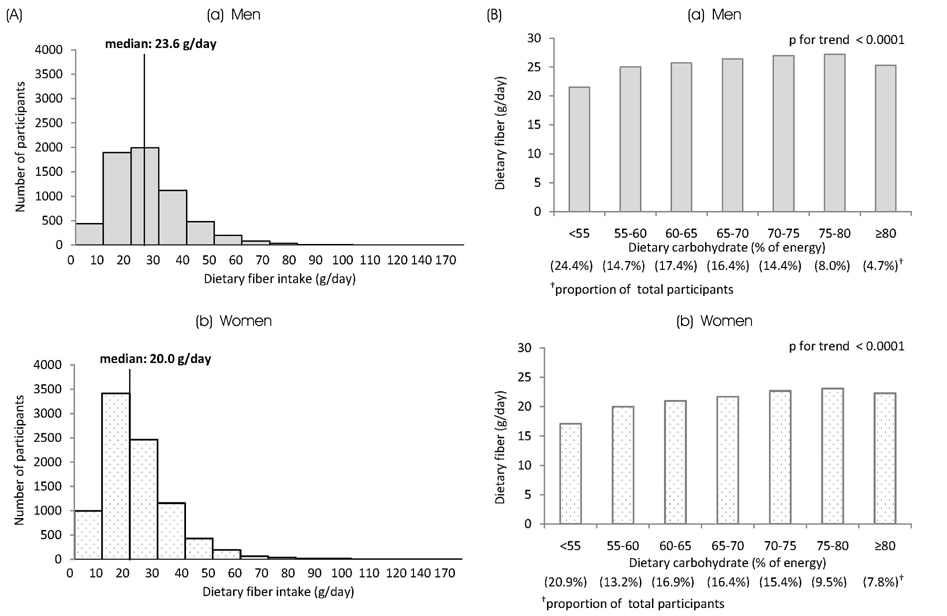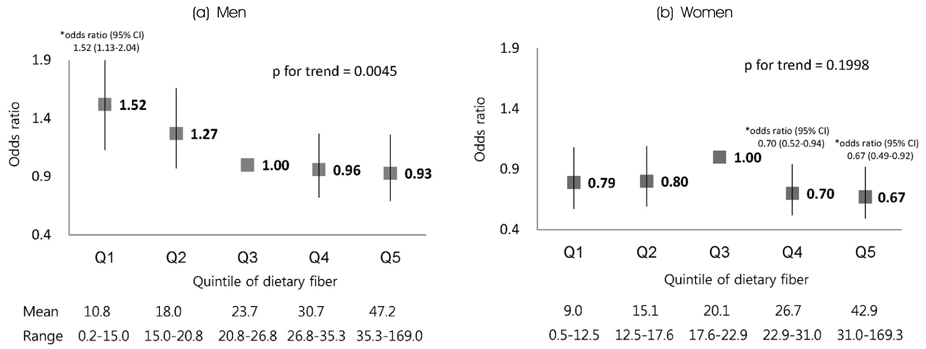J Nutr Health.
2019 Dec;52(6):540-551. 10.4163/jnh.2019.52.6.540.
High fiber and high carbohydrate intake and its association with the metabolic disease using the data of KNHANES 2013 ~ 2017
- Affiliations
-
- 1Department of Food Science and Nutrition, The Catholic University of Korea, Bucheon, Gyeonggi 14662, Korea. yjsong@catholic.ac.kr
- KMID: 2466668
- DOI: http://doi.org/10.4163/jnh.2019.52.6.540
Abstract
- PURPOSE
Dietary fiber is a component of carbohydrate that is linked closely with the carbohydrate quality, but few studies have investigated the association of high fiber intake with the cardiometabolic risk factors in Koreans. This study examined the association of high fiber and high carbohydrate intake with the cardiometabolic risk factors among Korean adults.
METHODS
This study included 15,095 adults aged ≥20 years, who participated in the 2013 ~ 2017 KNHANES. The dietary intake was obtained using a 24-h dietary recall method. The associations of high fiber and high carbohydrate intake with metabolic syndrome and dyslipidemia were examined by sex using multiple logistic regression analysis.
RESULTS
The median of dietary fiber was 23.6 g/day in men and 20.0 g/day in women. Dietary fiber intake increased gradually as dietary carbohydrate groups increased except for ≥80% of energy from the carbohydrate group. Women in the highest quintile of fiber intake showed a 33% lower risk of metabolic syndrome compared with those in the third quintile. When stratified into low fiber (LF) and high fiber (HF) groups using Adequate Intake of fiber for Koreans, men in the third quartile of carbohydrate intake showed a 44% and 51% higher risk of metabolic syndrome and atherogenic dyslipidemia than in the first quartile, respectively, but only in the LF group. Women in the second quartile of carbohydrate intake showed an 83% higher risk of hypercholesterolemia than in the first quartile in the LF group. On the other hand, as no significant association was observed between the carbohydrate intake and metabolic diseases among the HF groups in both sexes.
CONCLUSION
These findings suggest that a high fiber intake might be associated with a reduced risk of metabolic syndrome and high carbohydrate intake with a low dietary fiber intake might be associated with an increased risk of several metabolic abnormalities among Korean adults. Further prospective studies will be needed to confirm the effects of high fiber and high carbohydrate intake on the cardiometabolic risk factors among Koreans.
MeSH Terms
Figure
Reference
-
1. Chen JP, Chen GC, Wang XP, Qin L, Bai Y. Dietary fiber and metabolic syndrome: a meta-analysis and review of related mechanisms. Nutrients. 2017; 10(1):24.
Article2. Brown L, Rosner B, Willett WW, Sacks FM. Cholesterol-lowering effects of dietary fiber: a meta-analysis. Am J Clin Nutr. 1999; 69(1):30–42.
Article3. Fujii H, Iwase M, Ohkuma T, Ogata-Kaizu S, Ide H, Kikuchi Y, et al. Impact of dietary fiber intake on glycemic control, cardiovascular risk factors and chronic kidney disease in Japanese patients with type 2 diabetes mellitus: the Fukuoka Diabetes Registry. Nutr J. 2013; 12(1):159.
Article4. AlEssa HB, Cohen R, Malik VS, Adebamowo SN, Rimm EB, Manson JE, et al. Carbohydrate quality and quantity and risk of coronary heart disease among US women and men. Am J Clin Nutr. 2018; 107(2):257–267.
Article5. Wei B, Liu Y, Lin X, Fang Y, Cui J, Wan J. Dietary fiber intake and risk of metabolic syndrome: a meta-analysis of observational studies. Clin Nutr. 2018; 37(6 Pt A):1935–1942.
Article6. Morimoto N, Kasuga C, Tanaka A, Kamachi K, Ai M, Urayama KY, et al. Association between dietary fibre:carbohydrate intake ratio and insulin resistance in Japanese adults without type 2 diabetes. Br J Nutr. 2018; 119(6):620–628.
Article7. Yeon S, Oh K, Kweon S, Hyun T. Development of a dietary fiber composition table and intakes of dietary fiber in Korea national health and nutrition examination survey (KNHANES). Korean J Community Nutr. 2016; 21(3):293–300.
Article8. Lie L, Brown L, Forrester TE, Plange-Rhule J, Bovet P, Lambert EV, et al. The association of dietary fiber Intake with cardiometabolic risk in four countries across the epidemiologic transition. Nutrients. 2018; 10(5):628.
Article9. Grooms KN, Ommerborn MJ, Pham DQ, Djoussé L, Clark CR. Dietary fiber intake and cardiometabolic risks among US adults, NHANES 1999-2010. Am J Med. 2013; 126(12):1059–1067.e1-4.
Article10. Ministry of Health and Welfare. The Korean Nutrition Society. Dietary reference intakes for Koreans 2015. Sejong: Ministry of Health and Welfare, The Korean Nutrition Society;2015.11. Grundy SM, Cleeman JI, Daniels SR, Donato KA, Eckel RH, Franklin BA, et al. Diagnosis and management of the metabolic syndrome: an American Heart Association/National Heart, Lung, and Blood Institute scientific statement. Circulation. 2005; 112(17):2735–2752.12. Lee SY, Park HS, Kim DJ, Han JH, Kim SM, Cho GJ, et al. Appropriate waist circumference cutoff points for central obesity in Korean adults. Diabetes Res Clin Pract. 2007; 75(1):72–80.
Article13. Rhee EJ, Kim HC, Kim JH, Lee EY, Kim BJ, Kim EM, et al. 2018 Guidelines for the management of dyslipidemia. Korean J Intern Med. 2019; 34(4):723–771.
Article14. Austin MA, King MC, Vranizan KM, Krauss RM. Atherogenic lipoprotein phenotype. A proposed genetic marker for coronary heart disease risk. Circulation. 1990; 82(2):495–506.
Article15. United States Department of Agriculture, Agricultural Research Service. Food patterns equivalents intakes from food: mean amounts consumed per individual, by family income as % of poverty level and age, what we eat in America, NHANES 2015-2016 [Internet]. Washington, D.C.: United States Department of Agriculture, Agricultural Research Service;2018. cited 2019 Apr 30. Available from: www.ars.usda.gov/nea/bhnrc/fsrg.16. Public Health England. National diet and nutrition survey. Results from years 7 and 8 (combined) of the rolling programme (2014/2015 to 2015/2016). London: Public Health England;2018. p. .17. Ministry of Health, Labour and Welfare. The national health and nutrition survey in Japan. Tokyo: Ministry of Health, Labour and Welfare;2016.18. Wang HJ, Wang ZH, Zhang JG, Du WW, Su C, Zhang J, et al. Trends in dietary fiber intake in Chinese aged 45 years and above, 1991-2011. Eur J Clin Nutr. 2014; 68(5):619–622.
Article19. Cabello-Saavedra E, Bes-Rastrollo M, Martinez JA, Diez-Espino J, Buil-Cosiales P, Serrano-Martinez M, et al. Macronutrient intake and metabolic syndrome in subjects at high cardiovascular risk. Ann Nutr Metab. 2010; 56(2):152–159.
Article20. Moreno Franco B, León Latre M, Andrés Esteban EM, Ordovás JM, Casasnovas JA, Peñalvo JL. Soluble and insoluble dietary fibre intake and risk factors for metabolic syndrome and cardiovascular disease in middle-aged adults: the AWHS cohort. Nutr Hosp. 2014; 30(6):1279–1288.21. Kouki R, Schwab U, Hassinen M, Komulainen P, Heikkilä H, Lakka TA, et al. Food consumption, nutrient intake and the risk of having metabolic syndrome: the DR's EXTRA Study. Eur J Clin Nutr. 2011; 65(3):368–377.
Article22. Silva FM, Steemburgo T, de Mello VD, Tonding SF, Gross JL, Azevedo MJ. High dietary glycemic index and low fiber content are associated with metabolic syndrome in patients with type 2 diabetes. J Am Coll Nutr. 2011; 30(2):141–148.
Article23. Weickert MO, Pfeiffer AF. Metabolic effects of dietary fiber consumption and prevention of diabetes. J Nutr. 2008; 138(3):439–442.
Article24. Papathanasopoulos A, Camilleri M. Dietary fiber supplements: effects in obesity and metabolic syndrome and relationship to gastrointestinal functions. Gastroenterology. 2010; 138(1):65–72.e1-2.
Article25. McKeown NM, Meigs JB, Liu S, Saltzman E, Wilson PW, Jacques PF. Carbohydrate nutrition, insulin resistance, and the prevalence of the metabolic syndrome in the Framingham Offspring Cohort. Diabetes Care. 2004; 27(2):538–546.
Article26. Hosseinpour-Niazi S, Mirmiran P, Mirzaei S, Azizi F. Cereal, fruit and vegetable fibre intake and the risk of the metabolic syndrome: a prospective study in the Tehran Lipid and Glucose Study. J Hum Nutr Diet. 2015; 28(3):236–245.
Article27. Steemburgo T, Dall'Alba V, Almeida JC, Zelmanovitz T, Gross JL, de Azevedo MJ. Intake of soluble fibers has a protective role for the presence of metabolic syndrome in patients with type 2 diabetes. Eur J Clin Nutr. 2009; 63(1):127–133.
Article28. Ha K, Kim K, Chun OK, Joung H, Song Y. Differential association of dietary carbohydrate intake with metabolic syndrome in the US and Korean adults: data from the 2007-2012 NHANES and KNHANES. Eur J Clin Nutr. 2018; 72(6):848–860.
Article
- Full Text Links
- Actions
-
Cited
- CITED
-
- Close
- Share
- Similar articles
-
- Development of a Dietary Fiber Composition Table and Intakes of Dietary Fiber in Korea National Health and Nutrition Examination Survey (KNHANES)
- Carbohydrate Intake Exhibited a Positive Association with the Risk of Metabolic Syndrome in Both Semi-Quantitative Food Frequency Questionnaires and 24-Hour Recall in Women
- The effect of high-carbohydrate diet and low-fat diet for the risk factors of metabolic syndrome in Korean adolescents: Using the Korean National Health and Nutrition Examination Surveys (KNHANES) 1998-2009
- Low-Carbohydrate Diets in Korea: Why Does It Matter, and What Is Next?
- Association between Dietary Carbohydrate Intake and Cardiovascular Risk Factors According to Low-Density Lipoprotein Cholesterol Levels in Korean Adults



